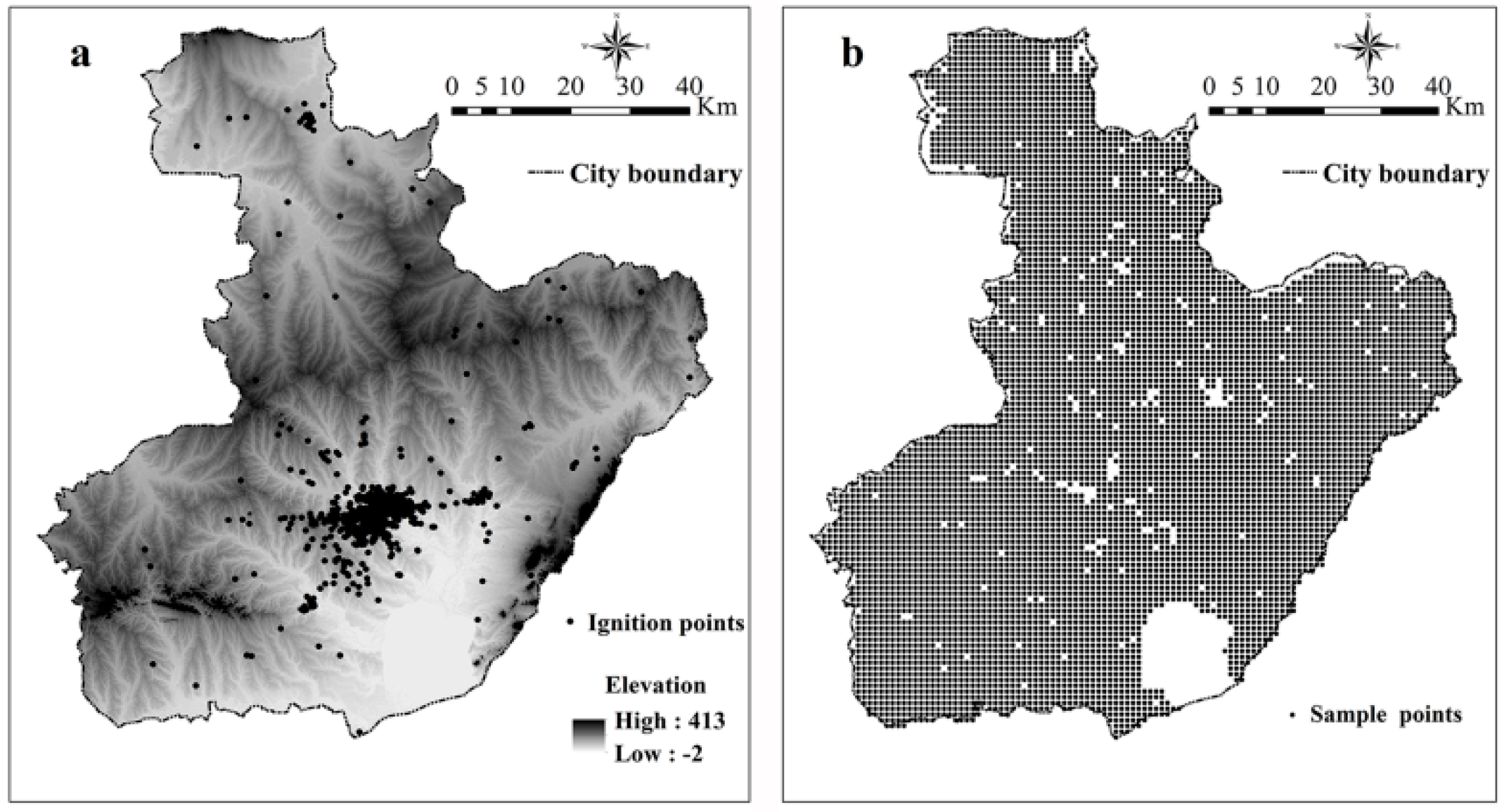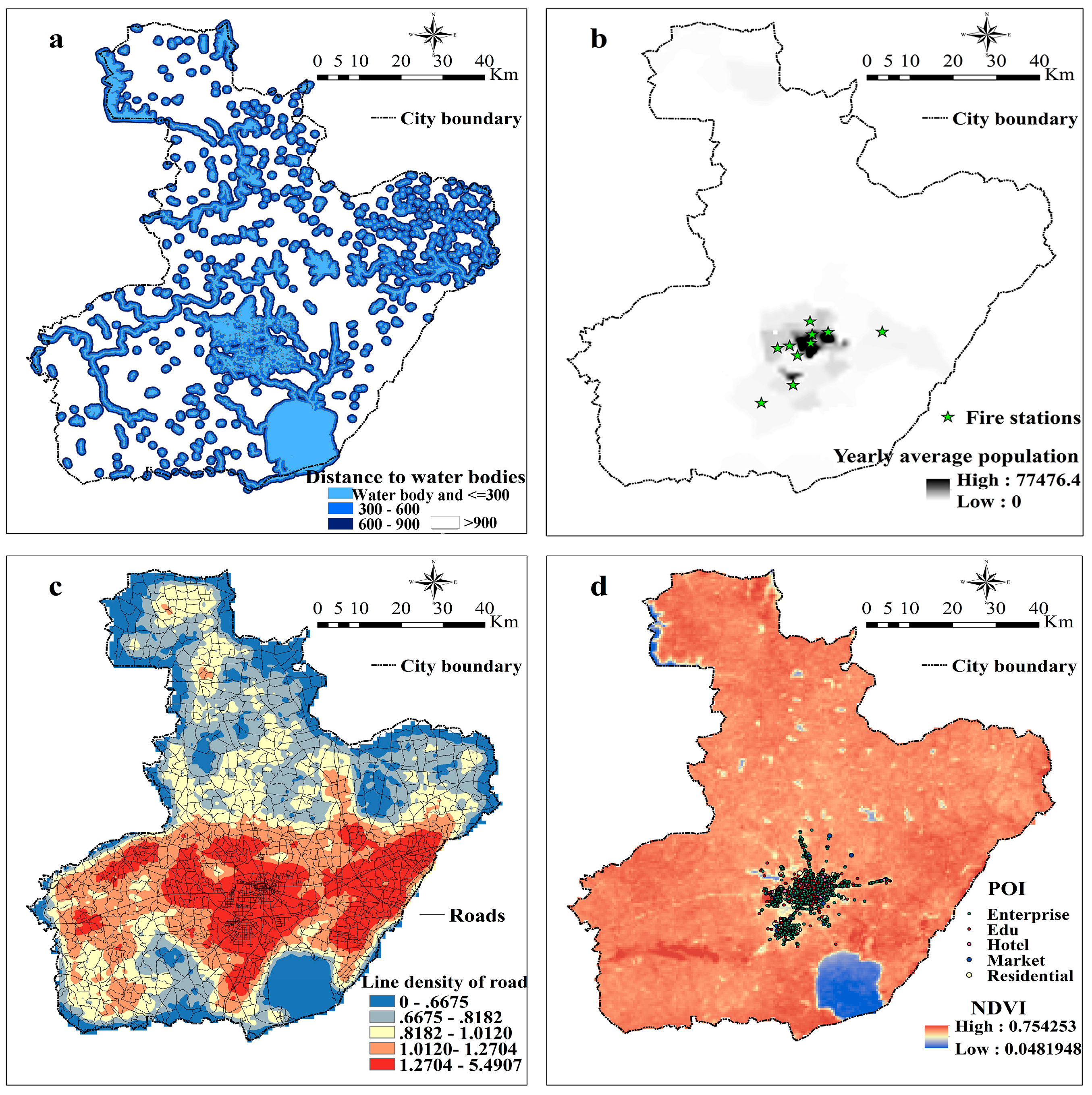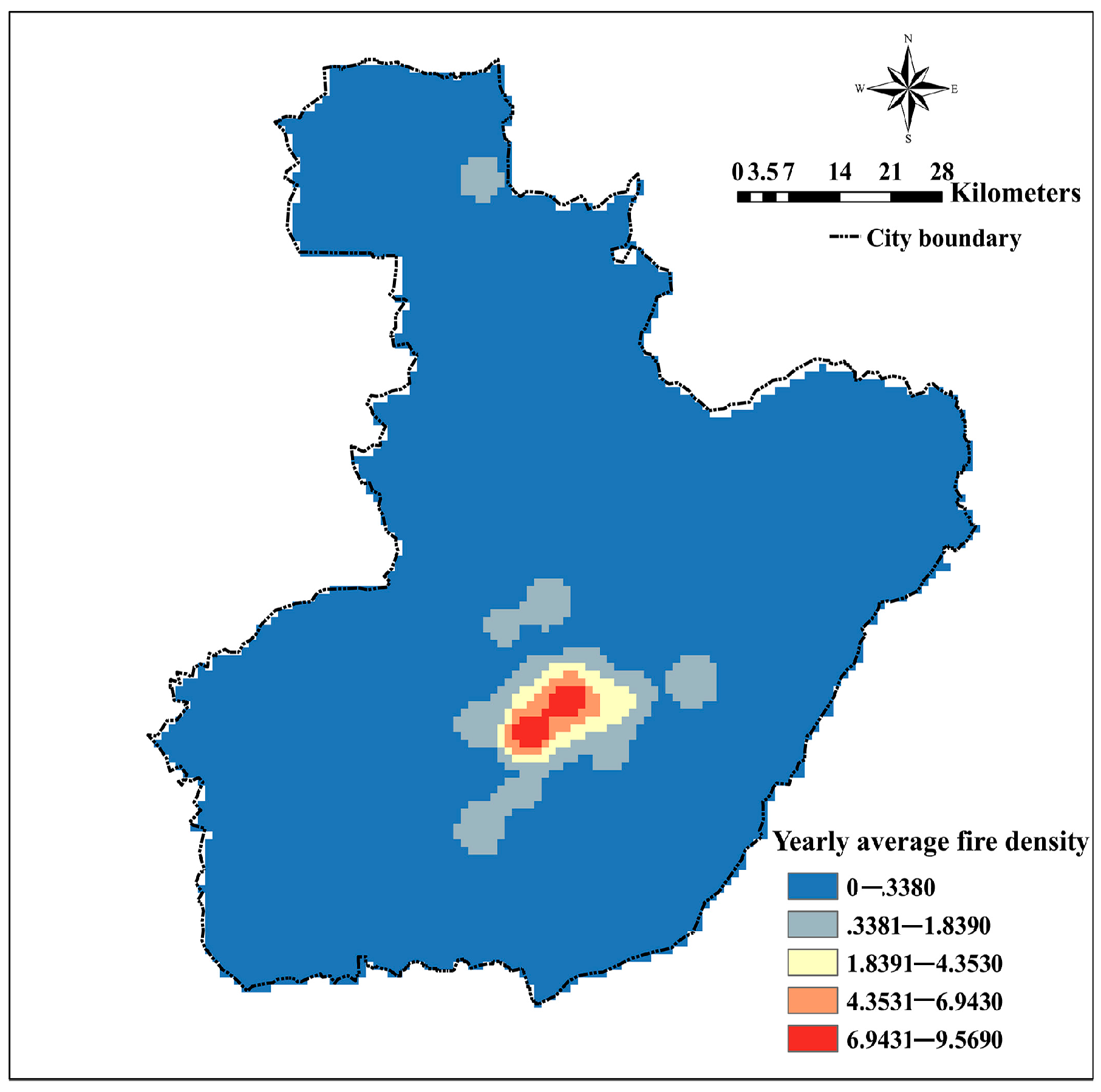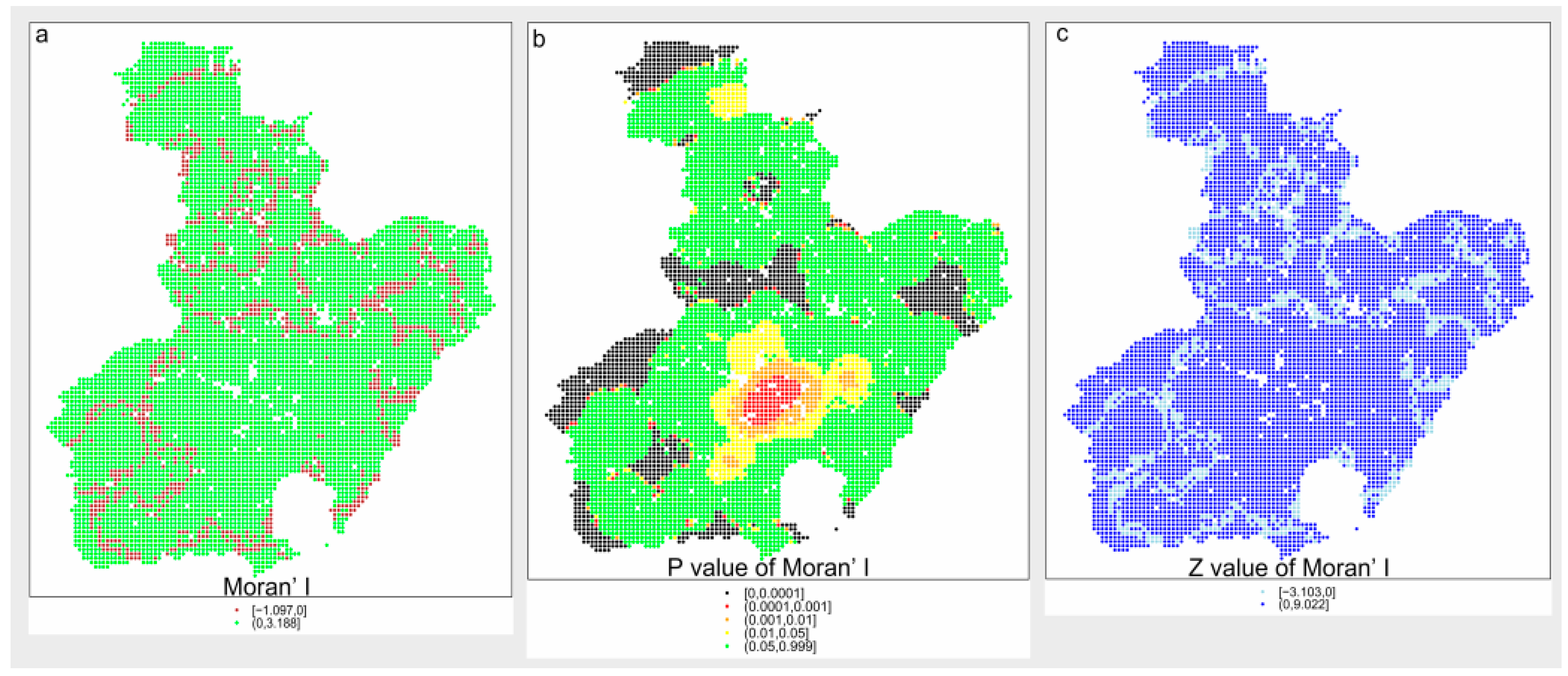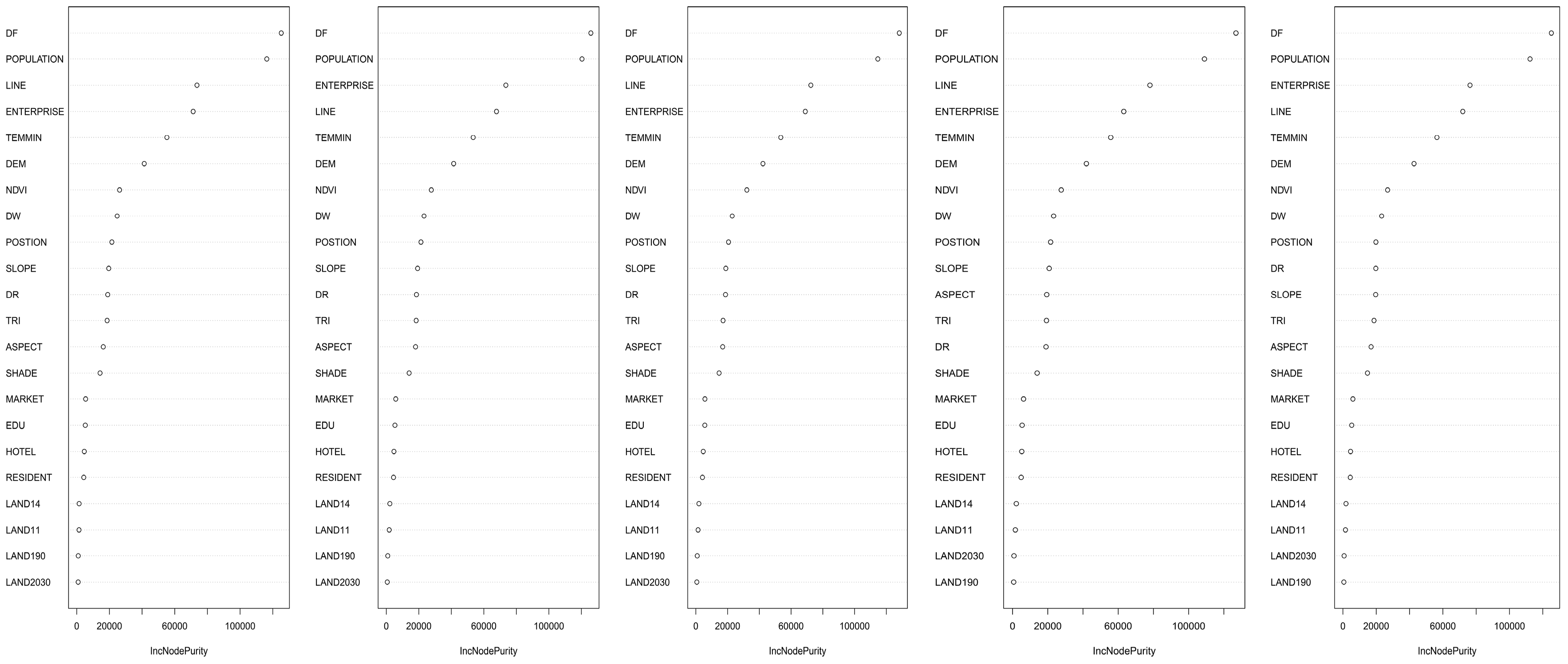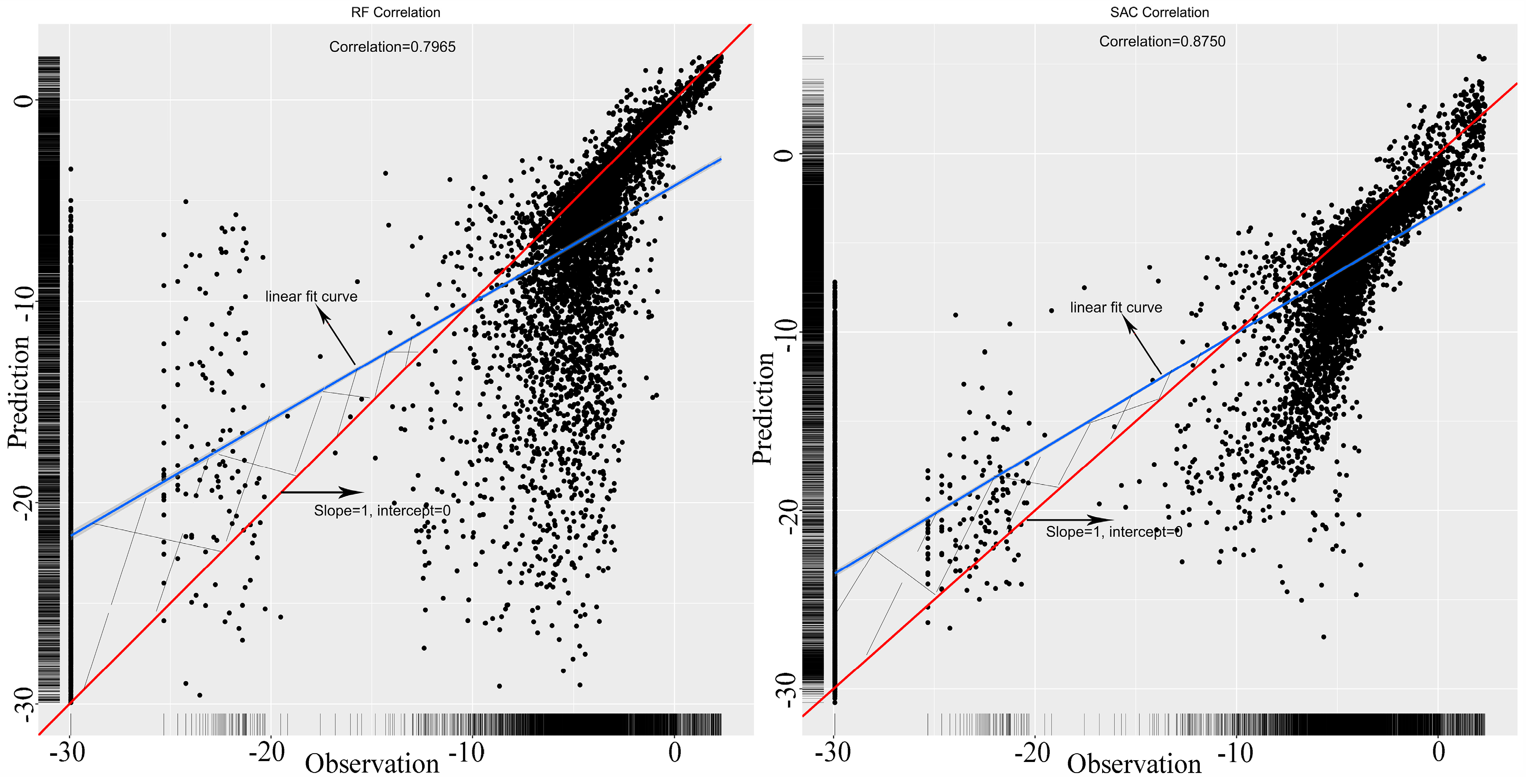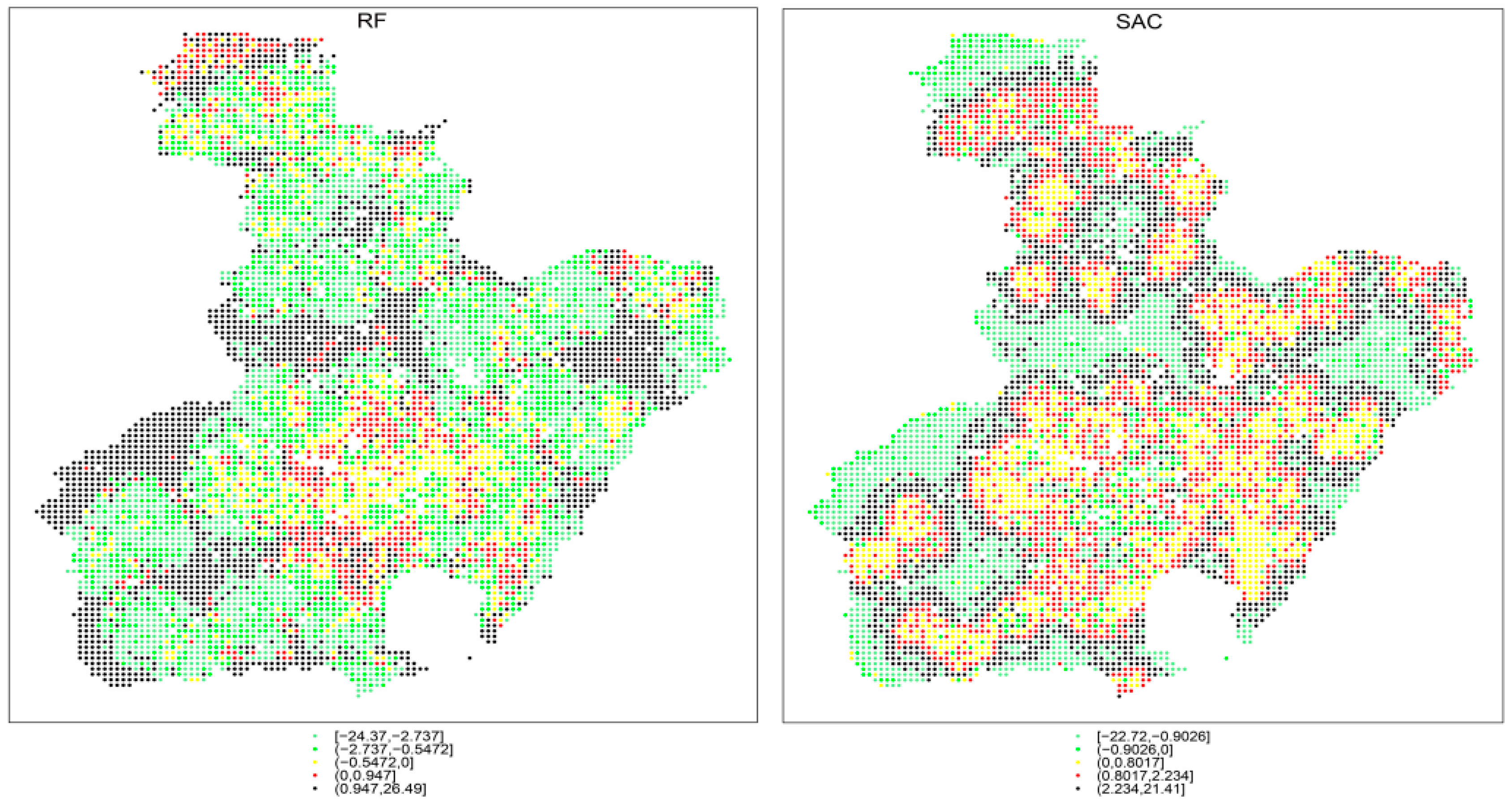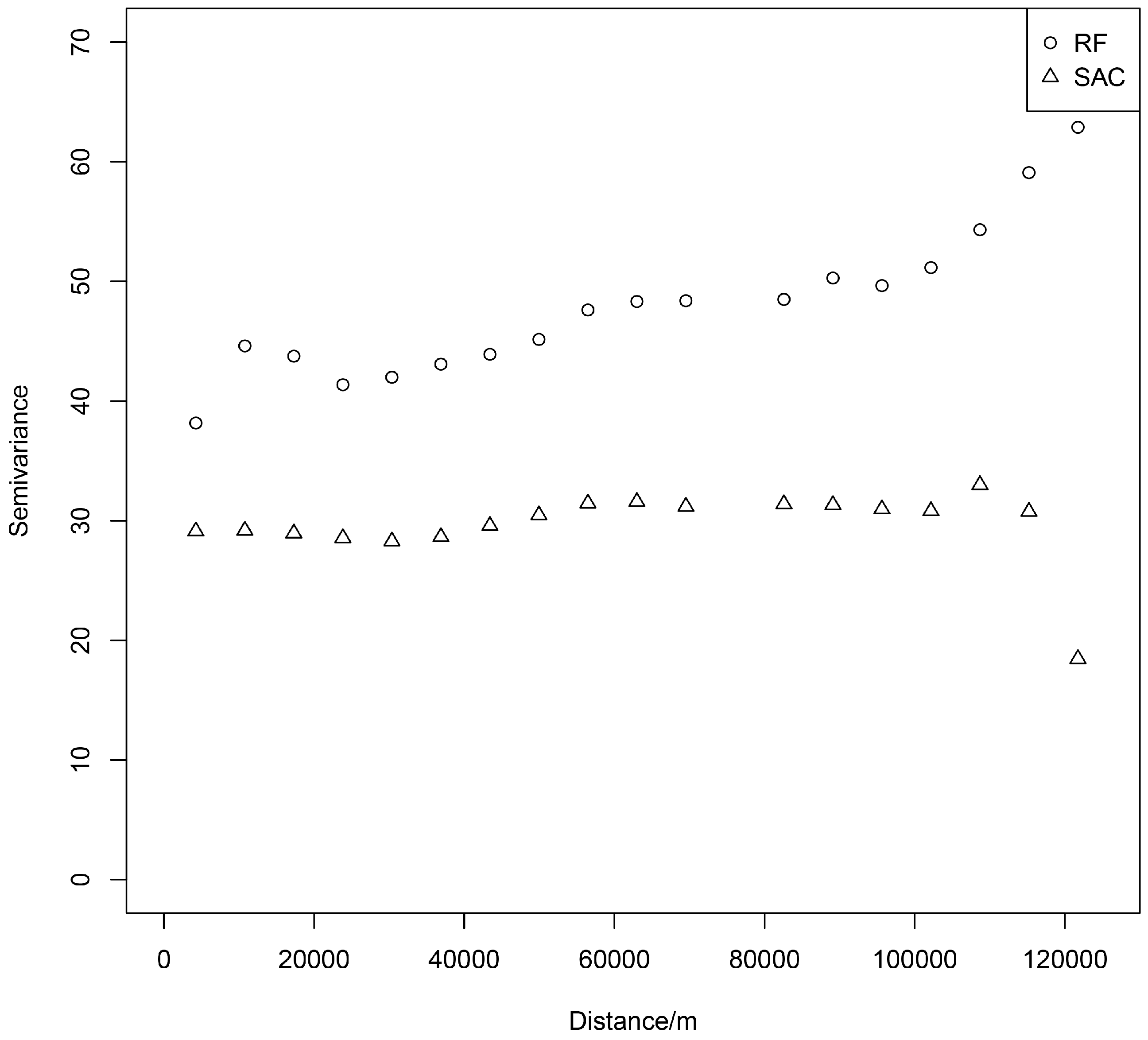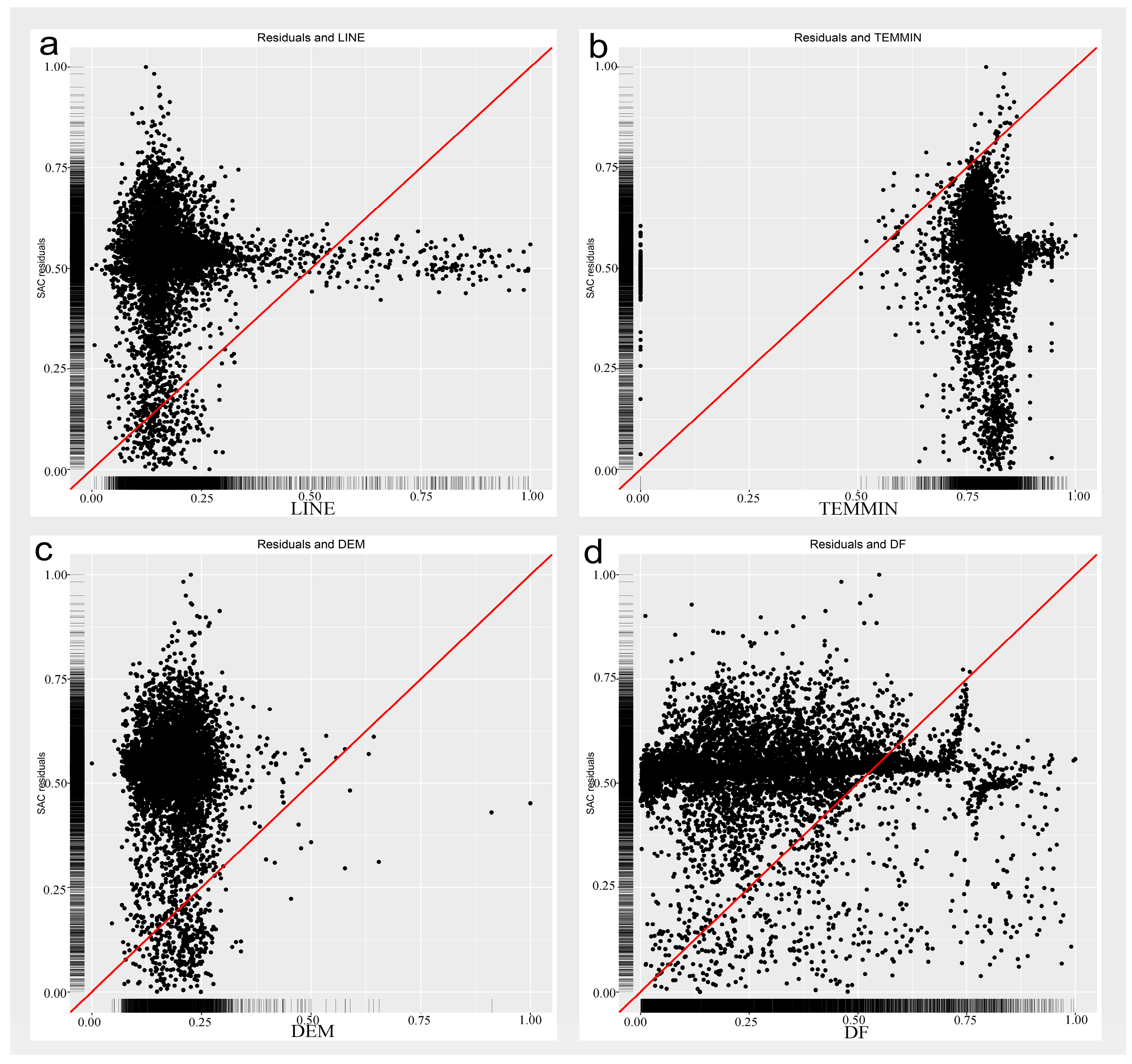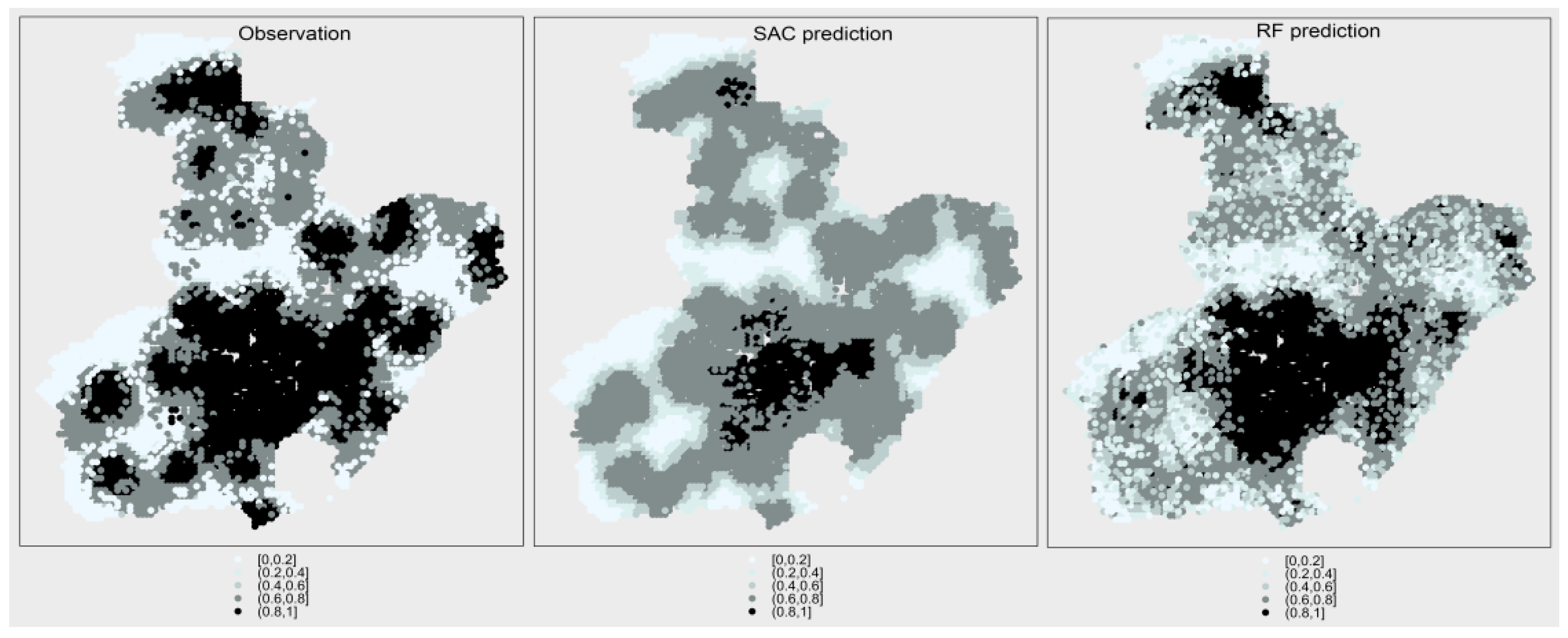2.4. Method
Considering the characteristic of spatial data such as the dependence and heterogeneity, some indicators including Moran’s
I and Geary’s
C index were used in the analysis of global autocorrelation for natural complex phenomena. The global and local Moran’s
I are shown in Equations (1) and (2), and the related
Z score of local Moran’s
I is shown in Equations (3) [
15]:
where
is the number of spatial units;
and
are the values of variable
in spatial unit
and
;
is the average over all spatial units of the variable.
is the spatial weight matrix that measures the strength of the relationship between two spatial units. The index value of global Moran’s
I falls between −1.0 and 1.0. The global spatial autocorrelation tool is an inferential statistic, which means that the results of the analysis are always interpreted within the context of its null hypothesis. However, the global Moran’s
I does not indicate where the clusters are located or what type of spatial autocorrelation is occurring. Therefore, the local Moran’s
I was calculated and the significance test of local Moran’s
I was applied with a local
Z test as an indicator of local spatial association, as shown in Equation (3). In addition, the correlative value of significance level could be calculated from the local
Z test at different significance levels including 0.01, 0.05, 0.1, etc. What is more, if the value of
Zi is positive and the local Moran’s
Ii is significant, then the result indicates that the spatial units with higher values are surrounded by neighboring units, which indicates positive local spatial autocorrelation. After detailed analysis for the existence of global and local spatial autocorrelation, SE models were used accordingly. Based on such early-stage preparation of cross-sectional data, SE models are being utilized more and more widely due to their advantages compared with traditional multiple linear regression [
30]. Before making decisions about which of the SE models is best, Moran’s
I was tested for the response variable and SE models would be trained first in each subsample in order to find the significant explanatory variables according to the Student’s
t-test. Each significant variable should fulfill the criteria of
p < 0.05 and the variables selected in the final SE model should be presented at least three times in the five initial SE training models.
Firstly, we conducted the Moran’s I test in the 6985 sample points and the spatial autocorrelation of fire density was managed before we could adopt SE models in this research. The map of local Moran’ I index was extracted and calculated with the “localmoran” function in R studio and spatial weight matrix was obtained. We can find the local regions where spatial clustering of fire occurrence is significant or not, as well as the hot points where fire happens most. In this paper, we adopted ‘‘KNN (K-nearest-neighbor)’’ as the method for building a spatially weighted matrix and 8 as the K value, which means the nearest eight neighbors around a single sample point were assigned a value of 1 in the spatially weighted matrix. Afterwards, we divided the whole sample dataset into five folds by using “createMultiFolds” function in R studio. Each sample fold was used as the testing set in turn and thus we could get five intermediate models by referring to the ideas of cross-validation. This means that 80 percent of samples were used as the training set and the other 20 percent of samples were the testing set; both SE and RF models were trained five times, and thus five intermediate models for these two regression methods were obtained. Each training set has 5588 sample points and each testing set has 1397 sample points.
In addition, SE models have three basic patterns, SEM, SLM, and SAC, as shown in Equations (4)–(6). Moreover, SDM is developed with the extension of SAC, which considers spatial lagging between explanatory variables, as shown in Equation (7). All of the SE models are parametric models, whose coefficients can be obtained accordingly. After pre-processing for the explanatory models, SDM, SEM, SLM, and SAC were implemented in this study using the packages of “sp” and “spdep”; “train”, “lagsarlm”, “errorsarlm”, ”knearneigh” and “nb2listw” functions were employed in RStudio (R Development Core Team, Boston, MA, USA) [
28]. R is an open-source software widely used in spatial analysis and prediction due to its advanced integration with GIS and other data formats [
31]. The packages and functions mentioned above were all applied because of their excellent performance on spatial econometrics. The formulations of SE models are shown below [
30]:
SEM:
where
means the vector of response variable,
means the matrix of
independent predictors,
reflects the coefficient matrix of
,
means the vector of random error term,
means the coefficients of spatial random error terms for the vector of cross-sectional response variable,
means the spatial lag of
,
means the vector of random error term under normal distribution.
SLM:
where
means the vector of response variable,
means the matrix of
independent predictors,
reflects the coefficient matrix of
,
means the vector of random error term,
means the coefficients of spatial regression terms,
means the
spatial weight matrix,
means the spatial-lag response variable.
SAC:
where
means the vector of response variable,
means the matrix of
independent predictors,
reflects the coefficient matrix of ,
X means the vector of random disturbance term,
means the coefficients of spatial regression terms,
means the
spatial weight matrix,
means the spatial-lag response variable,
means the coefficients of spatial random error terms for the vector of cross-sectional response variable,
means the spatial lag of
, and
means the vector of random error term under normal distribution.
SDM:
where
means the vector of response variable,
means the matrix of
independent predictors,
reflects the coefficient matrix of
,
means the vector of random disturbance term,
means the coefficients of spatial regression terms,
means the
spatial weight matrix,
means the spatial-lag response variable,
means the coefficients of spatial random error terms for the vector of cross-sectional response variable,
means the spatial lag of
, and
means the vector of random error term under normal distribution.
On the other hand, as other studies have depicted before, RF has become one of the most important machine learning methods based on ensemble learning [
2,
8,
32,
33,
34]. It is developed as the extension of decision trees [
35]. This algorithm applies random binary trees that use a subset of the observations through bootstrapping techniques. From the original dataset, a random choice of the training data is sampled and used to build the model accordingly, and the data not included are referred to as an “out-of-bag” (OOB) dataset [
2,
10]. This adds the element of randomness to bagging trees so as to make it less sensitive to variability in calibration such as outliers and data changes [
6]. It is also an extension of bagging trees because it adds random sampling to predictors in each subset, not only in sample sets. However, this method behaves as a “black box” since the individual trees cannot be examined separately and it calculates neither regression coefficients nor confidence intervals [
10]. Nevertheless, it allows for the computation of variable importance measures, which can be compared to other regression techniques. The studies before usually adopted %IncNodePurity and %IncMSE as the statistics for evaluating the importance of variables in the RF model [
10,
36,
37].
In addition, we used the technique called “recursive feature elimination (RFE)” in RStudio software in order to get the optimal number of predictors that should be included in the model. The detailed description of RFE algorithm is offered in the help section of the “caret” package in RStudio. What is more, by making use of such nonparametric techniques (formally called CART (classification and regression trees)), RF improves a lot on the level of accuracy and prediction and this advantage could offer technical support in the process of modeling fire occurrence. In this paper, we used “train”, ”rfFuncs”, “randomForest” and “rfeControl” function in “caret” package to select variables and get the initial five RF intermediate models. All of these operations were carried out on the RStudio software platform (R Development Core Team, Boston, MA, USA).
As specified before, different SE and RF models were trained and compared in order to get the final SE and RF models. They were validated afterwards in the testing set to examine the predictive ability for fire occurrence. Statistical results such as log likelihood, Akaike information criterion (AIC), coefficient of determination (R squared), root mean square error (RMSE), and correlation coefficient were obtained for the purpose of selecting the best model. Moreover, as a comparison in this paper, the RF model was also calibrated and optimized according to the criterion of %IncNodePurity, for which could assume that predictors with a greater value have higher importance [
38,
39]. %IncNodePurity relates to the loss function with which the best splits are chosen. The loss function is RMSE for regression and Gini impurity for classification. More useful variables achieve higher increases in node purities, through which we can find a split that has a high outer node “variance” and a small intra node “variance.” The final variables selected in the RF model can be chosen according to the average value of %IncNodePurity within five intermediate models. Finally, the SE and RF models were fitted in the whole dataset and the residuals of the two models were extracted from the prediction results.
As presented in the research before, if no autocorrelation remained in the residuals of the regression models, then the spatial pattern observed in the dependent variable could be explained by the spatial pattern observed in the predictors [
10]. Based on such prior knowledge, semivariograms of the residuals produced by different regression models were derived and these residuals were further visualized with different colors in order to examine the heterogeneity and unsteady performance. What is more, the correlations between the common predictors in both models and the residuals of each method were discussed in order to explore the factors that affected the generation of residuals.
Lastly, the maps of likelihood of fire occurrence predicted using RF and SE models were obtained by normalization of the fire density. Maps of the likelihood of fire occurrence were plotted as a comparison for each model, making it easier for people to understand the probability of ignition from the perspective of fire science.

